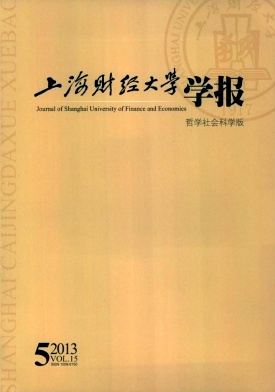技术进步方向及其劳动收入分配效应检验
上海财经大学学报 2013 年 第 15 卷第 05 期, 页码:65 - 72
摘要
参考文献
摘要
前沿文献忽视技术进步方向对要素收入分配的影响,为此,文章考察了我国适宜性生产函数并测算了技术进步方向及其收入分配效应。结果发现,1978-2010年间有偏性生产函数描述我国经济产出更优,技术进步正朝有利于资本的方向发展,其偏向水平不断强化并不断降低劳动收入占比,表明解决劳动收入占比下降应关注技术进步方向问题。
[1]戴天仕,徐现祥.我国技术进步方向[J].世界经济,2010,(11).
[2]罗长远.卡尔多“特征事实”再思考:对劳动收入占比的分析[J].世界经济,2008,(11).
[3]罗长远,张军.经济发展中的劳动收入占比:基于中国产业数据的实证研究[J].中国社会科学,2009,(4).
[4]唐东波.全球化与劳动收入占比:基于劳资议价能力的分析[J].管理世界,2011,(8).
[5]王林辉,韩丽娜.技术进步偏向性及其要素收入分配效应[J].求是学刊,2012,(1).
[6]王晓芳,高榴.教育提升了劳动收入占比吗[J].财经科学,2011,(9).
[7]王永进,盛丹.要素积累、偏向型技术进步与劳动收入占比[J].世界经济文汇,2010,(4).
[8]杨俊.经济分权模式下地方政府赶超与劳动收入占比[J].财经研究,2010,(8).
[9]张琪.我国就业增长缓慢与劳动收入占比下降之谜[J].人口与经济,2012,(5).
[10]张军,章元.对我国资本存量K的再估计[J].经济研究,2003,(7).
[11]Acemoglu D.Directed Technical Change[J].The Review of Economic Studies,2002,69(4):781-809.
[12]Decreuse B.,Maarek P.FDI and the Labor Share in Developing Countries:A Theory and Some Evidence[R].MPRA Working Paper,No.11224,2008.
[13]Giammarioli N.,Mwssina J.,Steinberger T.,Strozzi C.European Labor Share Dynamics:An Institutional Perspective[R].ECO Working Paper,No.2002/13,2002.
[14]Kalleberg A.L.,Wallace M.,Raffalovich L.E.Accounting for Labor’s Share:Class and Income Distribution in the Printing Industry[J].Industrial and Labor Relations Review,1984,(3):386-402.
[15]Klump R.,McAdam P.,Willman A.Unwrapping Some Euro Area Growth Puzzles:Factor Substitution,Productivity and Unemployment[J].Journal of Macroeconomics,2008,30:645-666.
[16]Klump R.,McAam P.,Willman A.Factor Substitution and Factor-Augmenting Technical Progress in the United States a Normalized Supply-Side System Approach[J].Review of Economic and Statistic,2007,89:183-192.
[17]Sato R.The Estimation of Biased Technical Progress and the Production Function[J].International Economic Review,1970,11:179-201.
[18]Sato P.,Morita T.Quantity or Quality:The Impact of Labor Saving Innovation on US and Japanese Growth Rates,1960-2004[J].The Japanese Economic Review,2009,60:407-434.
[2]罗长远.卡尔多“特征事实”再思考:对劳动收入占比的分析[J].世界经济,2008,(11).
[3]罗长远,张军.经济发展中的劳动收入占比:基于中国产业数据的实证研究[J].中国社会科学,2009,(4).
[4]唐东波.全球化与劳动收入占比:基于劳资议价能力的分析[J].管理世界,2011,(8).
[5]王林辉,韩丽娜.技术进步偏向性及其要素收入分配效应[J].求是学刊,2012,(1).
[6]王晓芳,高榴.教育提升了劳动收入占比吗[J].财经科学,2011,(9).
[7]王永进,盛丹.要素积累、偏向型技术进步与劳动收入占比[J].世界经济文汇,2010,(4).
[8]杨俊.经济分权模式下地方政府赶超与劳动收入占比[J].财经研究,2010,(8).
[9]张琪.我国就业增长缓慢与劳动收入占比下降之谜[J].人口与经济,2012,(5).
[10]张军,章元.对我国资本存量K的再估计[J].经济研究,2003,(7).
[11]Acemoglu D.Directed Technical Change[J].The Review of Economic Studies,2002,69(4):781-809.
[12]Decreuse B.,Maarek P.FDI and the Labor Share in Developing Countries:A Theory and Some Evidence[R].MPRA Working Paper,No.11224,2008.
[13]Giammarioli N.,Mwssina J.,Steinberger T.,Strozzi C.European Labor Share Dynamics:An Institutional Perspective[R].ECO Working Paper,No.2002/13,2002.
[14]Kalleberg A.L.,Wallace M.,Raffalovich L.E.Accounting for Labor’s Share:Class and Income Distribution in the Printing Industry[J].Industrial and Labor Relations Review,1984,(3):386-402.
[15]Klump R.,McAdam P.,Willman A.Unwrapping Some Euro Area Growth Puzzles:Factor Substitution,Productivity and Unemployment[J].Journal of Macroeconomics,2008,30:645-666.
[16]Klump R.,McAam P.,Willman A.Factor Substitution and Factor-Augmenting Technical Progress in the United States a Normalized Supply-Side System Approach[J].Review of Economic and Statistic,2007,89:183-192.
[17]Sato R.The Estimation of Biased Technical Progress and the Production Function[J].International Economic Review,1970,11:179-201.
[18]Sato P.,Morita T.Quantity or Quality:The Impact of Labor Saving Innovation on US and Japanese Growth Rates,1960-2004[J].The Japanese Economic Review,2009,60:407-434.
引用本文
董直庆, 戴杰, 陈锐. 技术进步方向及其劳动收入分配效应检验[J]. 上海财经大学学报, 2013, 15(5): 65–72.
导出参考文献,格式为:





 5804
5804  321
321

